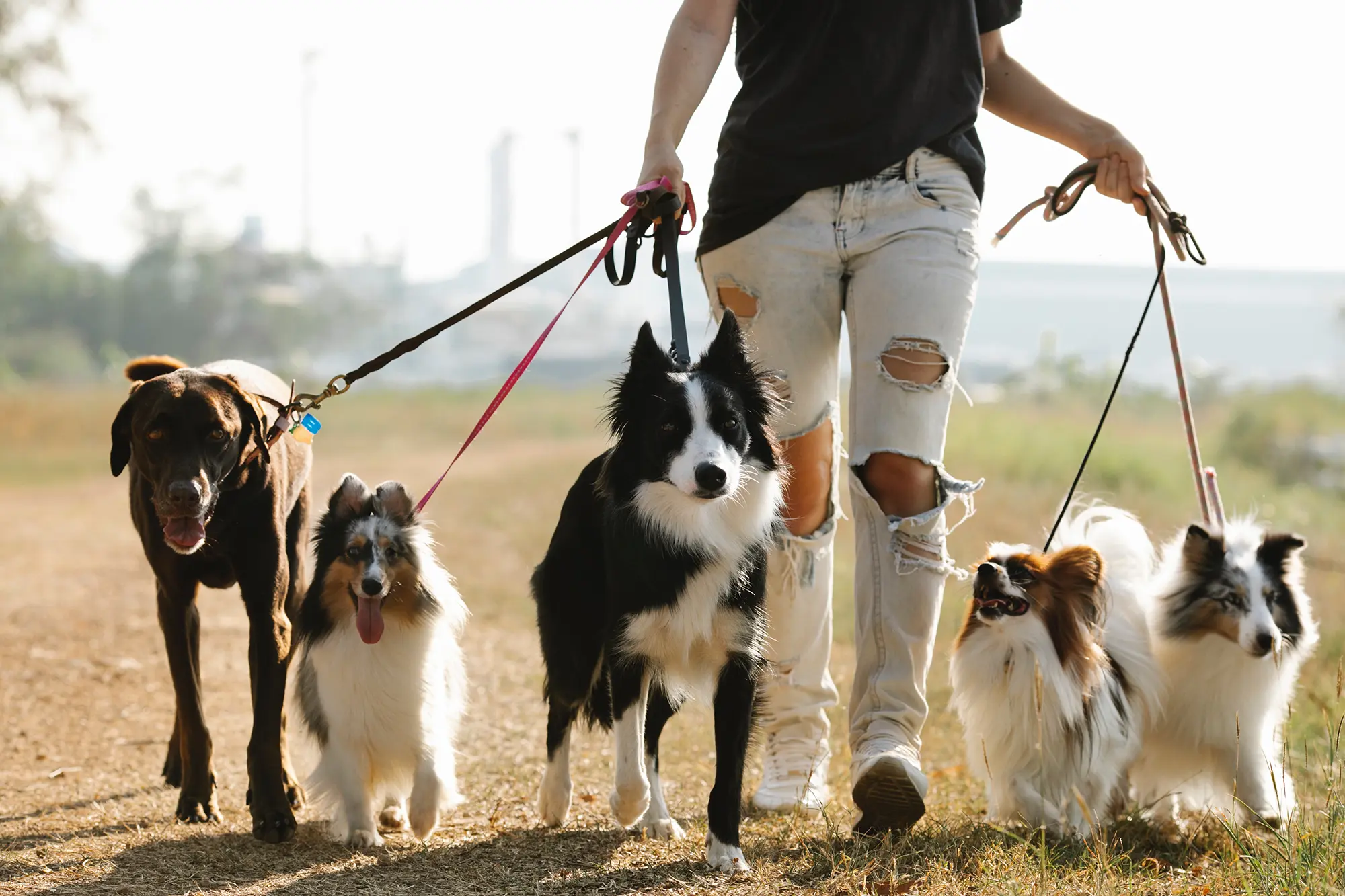paw care 101: how to take care of your dog's paws
Author: PawPots Team
 03 Apr 2023
03 Apr 2023
 7 min
7 min If your pup’s paws are smelly, the hair is overgrown or the nails are long, then they require veterinary attention. Here’s everything you need to know about your dog’s paws and how you – and your vet – can best take care of them!
The Biology Of Dog Paws
Paws are made of muscles, keratin, collagen, adipose (fat) tissue, ligaments, tendons, elastic fibers, and bone. This includes paw pads, covered by heavily pigmented and thick skin. They’re “cushions” that absorb shock and pressure, protect bones and joints against rough terrain and trauma. That being said, paws consist of five main “sections”:
1) Digital Pads
They’re the four small pads located on each toe and are used to support some of the dog’s weight and joints.
2) Claws:
They’re made of keratin, just like our nails! However, dogs’ claws grow right from the bone in their foot; they contain nerves and blood vessels, which is why trimming them can be tricky. Claws are used for digging, provide traction, and, if needed, help hold down and tear a prey.
3) Dewclaws
They’re the “extra” claw on the lower part of a dog’s leg. Most dog breeds have them on their front legs, others on their rear legs. For most dogs they serve no apparent purpose, but some dogs use them for gripping things they’re holding in their paws: like a bone or toy.
4) Carpal Pad
It’s a small pad located above the dewclaw. It’s found on the front leg of dogs (and other animals) that walk on their digits.
5) Metacarpal/Metatarsal Pad
This heart-shaped pad supports more of the dog’s weight, since it’s located at the center of their foot. The ones on the front paws are known as the metacarpal, or palmer, pads, whereas the ones on the rear paw are called the metatarsal, or plantar, pad.
The metacarpal pad offers protection from rough terrain, allows dogs to distinguish between different types of terrain, and also protects the feet from extremely hot or cold weather.
It’s All In The Grooming
Grooming isn’t just for skin and fur; your pet’s paws need it as well! It’s a key component of taking care of your dog’s paws. Proper grooming will help prevent injuries or discomfort and keep your pet’s paws feeling their best. Here are our tips:
Tip #1: Trim their Nails
Nail trimming can be stressful for dog owners and their furry friends because there are nerves and veins that run through their claws. If allowed to grow too long, nails can put pressure on the nail bed. Overgrown nails can also be ingrown, which means your pup is at greater risk of trauma.
How do you know when your dog needs their nails trimmed? Well, if your dog spends a lot of time inside, or on soft surfaces, then their nails need to be trimmed on a regular basis. Same with dogs who get older, as they get less exercise and may need more attention to their nails. Dogs that spend a lot of time running on hard surfaces, like concrete, may need less frequent trims, since the surface wears down the nails naturally. However, they may need more frequent trimming in the winter.
If you’ve never tried cutting your dog’s nails before, ask your vet to give you a lesson on how to do it. You may also decide to have your vet or groomer handle nail trimming generally.
Tip #2: Trim the Hair Between their Paw Pads
The hair on our dogs’ paws can get matted, and therefore cause pain. Whenever they grow longer than their paw pads, you need to trim them. Also, make sure you brush them own whenever you comb your pet!
Tip #3: Regular Paw-Checks
When you take your dog outside, debris, like small rocks, can often get stuck between their paw pads. It’s important to check them regularly and clean them. In most cases, they can be removed with a set of tweezers.
Tip #4: Moisturize & Massage
Pets love getting pampered! Not only will they love you for giving their paws a massage, but keeping their paws moisturized keeps them softer and less prone to injury or cracking. Massaging will help improve circulation to the paws as well: rub the space between their paw pads gently and in circular motions while placing your thumb on the back of the paw.
Prepped For The Outdoors
A change in the weather requires a change in your pet’s preventative care routine. Whether it’s hot or cold, your pet’s paws can crack or blister; limited exposure will be a necessity. It’s also important to note that if your pet spends most of their time indoors, their paws will be less used to the different terrains and more prone to injuries. It’s important to take them outdoors for short periods and then gradually increase their play/walk time.
Tip #1: Protect their Paws in Winter
When the temperatures drop and snow falls, you should limit the time your dog’s paws are in snow or begin using boots to protect their paws from the cold, sharp ice, rock salt, and other harmful substances. If you choose not to use boots, make sure to thoroughly wipe down your pet’s paws and check between paws to remove any residual ice and salt, as both can lead to cracking. Your pet may also be prone to licking their paws, which can be dangerous if they ingest any chemicals used to dissolve snow.
Tip #2: Protect their Paws in Summer
Similarly, during the hotter months, you will need to pay extra attention to your dog’s paws. Hot pavement and dirt can lead your dog’s paw pads to crack, burn or blister. Limit the time spent on pavement or dirt, or even hot beach sand during these days, and make sure to moisturize your pet’s paws regularly. A good way to check whether the ground is too hot is to place your palm on the ground for 5-10 seconds. If the temperature is too hot to keep your hand there, it’s too hot for your pet’s paws.
Paw Emergencies
A dog’s paws seem tough, but they’re still a sensitive part. If you do notice cracked dog paws, you can help at home with the right products and care. As with any injury, if symptoms worsen or appear severe, contact your veterinarian for treatment advice.
1) Excessive Licking and Chewing
If you notice your dog doing that, it could be a sign of an injury or irritant. Make sure to do a paw-check, clear out any debris, and wipe down their paws with antimicrobial hydrogel to soothe irritation and help promote healing. If the licking or chewing continues, contact your vet for further treatment advice.
2) Swelling of the Toes or Feet
It could have any number of causes, like a sign of bacterial infection or a foreign object that’s punctured the paw. In this instance, it would be best to take your pet to their vet.
3) Broken, Cracked or Ingrown Nails
Nail trauma is one of the most common issues and can range from the nail breaking to it being ripped out. It’s best to consult your vet to get the correct treatment and prevent infection.
4) Crusty, Cracked or Broken Skin on the Paw Pads
If you notice that you’ll need to rinse off the affected area with a wound care solution to clear away irritants. Afterwards, apply antimicrobial hydrogel to soothe the area and promote healing. You should also bandage the area to prevent any further injury to the paw.
5) Blisters and Burns
Your dog can burn their poor paws on steaming hot asphalt. If you’re walking on a hot day, check the pavement with your own hand.
Though we’re not expert groomers at PawPots, we love sharing our knowledge with our fellow PawPotters because we care about your pet’s health. Once you start paying attention to your pup’s paws, you’ll see a positive change in their behavior: they’ll be happy and much more comfortable!

Give Back The Love
Show your love to your pets with our high-quality, delicious and healthy meals! Show your love to your pets with our high-
quality, delicious and
healthy meals!






